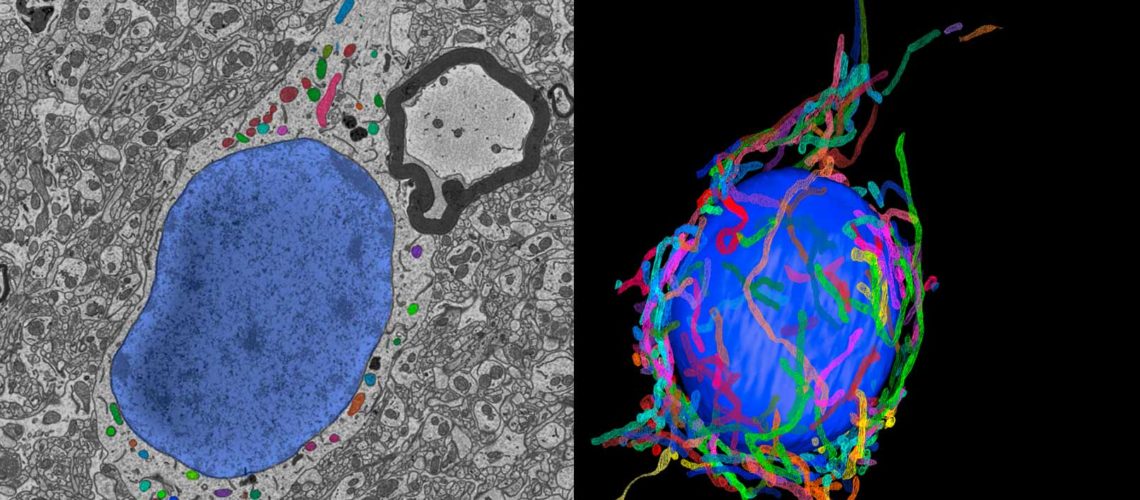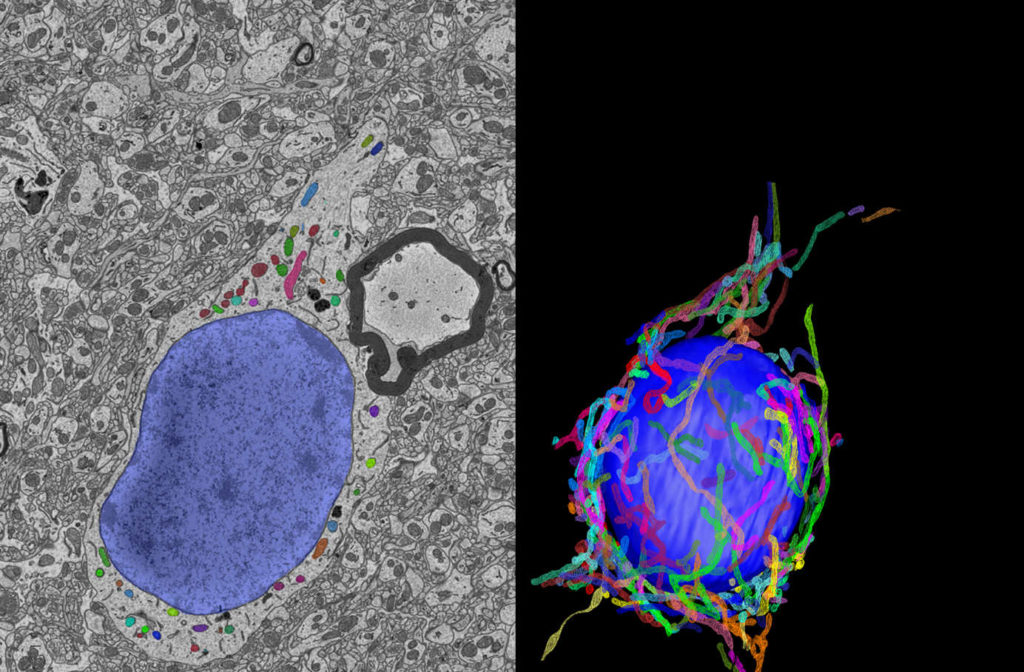Has the ideal target for treating anxiety been discovered?
11 February 2021

Synapsy’s neuroscientists based at EPFL have identified a cell molecule that can regulate anxiety and prevent depression. Located at the crossroads of multiple cellular mechanisms, this molecule reconciles the great heterogeneity of scientific observations and paves the way for future treatments.
People who suffer from anxiety are more prone to depression when they are exposed to stress, even though the cause and effect relationship is still poorly understood. Nevertheless, the scientific literature shows that the energy made available to the neurons and their morphology are probably involved in the onset of anxious behaviours that lead to depression. In a study published in the journal Biological Psychiatry, the Synapsy researchers used laboratory rats to take a closer look at the molecular composition of mitochondria, the cellular machinery responsible for producing energy. The scientists found that a protein expressed by the mitochondria of the neurons, Mitofusin-2, was less prevalent in anxious rats. This protein is involved in coordinating the mitochondria with the other organelles of the cell, with its reduced expression influencing both the morphology of the neurons and their energy production. The study shows that restoring the expression levels of Mitofusin-2 in anxious individuals makes it possible to return to non-anxious behaviour and prevents depression.
Original publication
Contact
Yann Bernardinelli
Press Officer
NCCR-Synapsy
Campus Biotech, UNIGE
+41 76 436 30 37
Yann.Bernardinelli@unige.ch
Carmen Sandi
Full Professor
Brain Mind Institute
Faculty of Life Sciences
EPFL
+41 21 693 95 34
carmen.sandi@epfl.ch
Synapsy’s neuroscientists based at EPFL have identified a cell molecule that can regulate anxiety and prevent depression. Located at the crossroads of multiple cellular mechanisms, this molecule reconciles the great heterogeneity of scientific observations and paves the way for future treatments.
People who suffer from anxiety are more prone to depression when they are exposed to stress, even though the cause and effect relationship is still poorly understood. Nevertheless, the scientific literature shows that the energy made available to the neurons and their morphology are probably involved in the onset of anxious behaviours that lead to depression. In a study published in the journal Biological Psychiatry, the Synapsy researchers used laboratory rats to take a closer look at the molecular composition of mitochondria, the cellular machinery responsible for producing energy. The scientists found that a protein expressed by the mitochondria of the neurons, Mitofusin-2, was less prevalent in anxious rats. This protein is involved in coordinating the mitochondria with the other organelles of the cell, with its reduced expression influencing both the morphology of the neurons and their energy production. The study shows that restoring the expression levels of Mitofusin-2 in anxious individuals makes it possible to return to non-anxious behaviour and prevents depression.
Stress-related illnesses, such as depression, are a real blight on our society. In Switzerland, the bill for stress stood at 7.63 billion in 2020 according to the Job Stress Index published by the Promotion Santé Suisse Foundation. Carmen Sandi is a neuroscientist at the EPFL’s Brain Mind Institute and a member of Synapsy, the Swiss National Centre of Competence in Research into Mental Illness. Professor Sandi underlines the urgency of finding novel treatment targets for depression — and anxiety in particular, since anxious individuals are more prone to depression when exposed to stress. “Current treatments aren’t very effective, and they only work for a small percentage of people. This limited success is most probably down to the fact that anxiety results from a range of different brain mechanisms, leading to equally heterogeneous behaviours and even mental illnesses, including depression. Under these conditions,” continues the researcher, “it’s very difficult to identify new therapeutic targets.”
Finding the common denominator
Professor Sandi’s laboratory has known for several years, from their own work and epidemiological studies in the literature, that there is a link between anxiety and depression. In fact, the laboratory’s research on rats has succeeded in demonstrating that highly anxious individuals fall into depression more easily than individuals with low levels of anxiety, although it has not been able to pinpoint the mechanisms that link anxiety and depression. In this study, the scientists show that the morphology of the neurons is impacted along with the density of their points of contact, the synapses, in an area of the brain that is important for motivation, known as the nucleus accumbens. This results in an alteration in brain connectivity and plasticity. In addition, the mitochondria —the cellular organs responsible for producing energy— become swollen, generate less energy and have less contact with the other organelles in the cell. “This suggests that something is happening to the coordination between the organelles. The drop in energy production involves the mitochondria, and the alterations in neuronal morphology and synapses probably involve the organelles responsible for producing and managing proteins for the cell, such as the endoplasmic reticulum,” adds Professor Sandi.
Anxiety targeted at last
In order to capture the mechanisms leading to these observations to identify therapeutic targets, the researcher and her colleagues observed that anxious rats exposed to stressful situations display depressive-like behaviour. Simone Astori, a senior scientist at EPFL and co-author of the study, explains further: “We examined the behaviour of the rats in anxiety and depression-related tasks, as well as the morphology of their neurons using imaging, and their connectivity using electrophysiology. Our data suggested that the alterations we found might be deriving from a mitochondrial dysfunction.” From many molecules measured, the mitochondrial protein Mitofusin-2 correlated with defects in the synaptic and mitochondrial structure. “Mitofusin-2 is under-expressed in the neurons of highly anxious rats in the nucleus accumbens”, begins Elias Gebara, a postdoctoral collaborator at EPFL and the study’s first author. “As its role is precisely the coordination between the mitochondria and endoplasmic reticulum, it is a particularly interesting target.”
Natural treatments on the way
Using genetic tools, the neuroscientists then succeeded in restoring the Mitofusin-2 protein in the neurons of the nucleus accumbens of the anxious rats to physiological levels. The rats that underwent this treatment no longer had an energy production failure or structural problems at their synapses. More importantly, they no longer showed depressive-like behaviours when exposed to stressful challenges. “All their functions —both physiological and behavioural— were recovered, and the rats weren’t anxious anymore! This seems to confirm that we have found an ideal target for future treatments”, continues Gebara. With the help and inspiration of the Synapsy consortium, the researchers will now try to develop a treatment targeting Mitofusin-2. “We’re not going to develop new drugs, but prioritise natural pathways. Specific nutrients are capable of regulating the expression of this protein, with the goal of exploiting diet to put a treatment in place,” says Professor Sandi by way of conclusion.
By Yann Bernardinelli, Press Officer NCCR-Synapsy

Mitochondria and anxiety
Electron microscopy images (left) of brain tissue taken from the nucleus accumbens showing the nucleus of a neuron (in blue) and mitochondria (all the other colours). The image on the right is a three-dimensional reconstruction of the mitochondria of the same neuron. Each colour corresponds to a single mitochondrion. © EPFL/Elias Gebara
Original publication
Contact
Yann Bernardinelli
Press Officer
NCCR-Synapsy
Campus Biotech, UNIGE
+41 76 436 30 37
Yann.Bernardinelli@unige.ch
Carmen Sandi
Full Professor
Brain Mind Institute
Faculty of Life Sciences
EPFL
+41 21 693 95 34
carmen.sandi@epfl.ch
